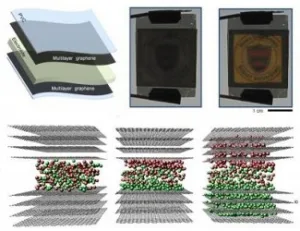Electrochromic displays, which change their state (i.e. opaque to transparent) when exposed to electricity, potentially offer low cost and mechanical flexibility. However, fragile materials and material mismatches with the electrodes have so far hampered the performance of these displays. Now researchers at Turkey’s Bilkent University have used graphene to create an electrochromic device with 55% modulation; optical tuning properties in the ultraviolet to infrared; acceptable electrical conductivity with no material mismatches; and mechanical flexibility.
Bilkent’s device uses graphene for the electrode and the colour-changing electrochromic material. Previously, the researchers had shown a device using single-layer graphene on glass and quartz substrates; this had between 2% and 3% optical modulation. The device was limited by graphene’s optical absorption, without a high contrast ratio. It was difficult to solve the issue by adding additional graphene layers; the deposition process onto hard substrates damaged the multilayer graphene and harmed its electrochromic properties.
The new device was developed by producing multiple graphene layers on non-rigid nickel and copper foils, then laminating it with PVC at 120 deg . An electrolyte liquid was sandwiched between two graphene-on-PVC films to form the finished product.
Whether the material can be used in displays is unclear at this point, although it could certainly see use in smart windows and mirrors.
The research was published in the journal Scientific Reports, and can be found at http://tinyurl.com/m82c6rd.

